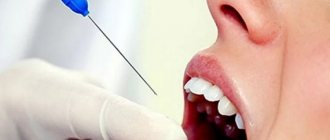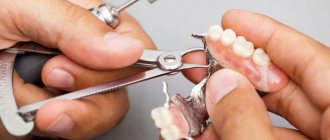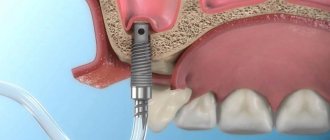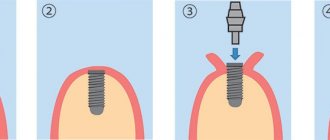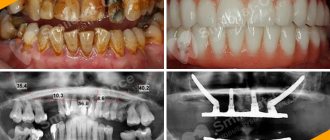The patient usually first hears about bone tissue atrophy when preparing for dental implantation. And he is surprised to learn that it is not possible to install standard implants, since due to a long absence of teeth or the choice of a removable denture, the bone tissue has noticeably decreased in volume.
The main cause of bone tissue atrophy is considered to be tooth extraction, and the bone begins to decrease in size within three months after the loss of a living tooth and reaches its apogee within a year. That is why it is necessary to take care of the issue of dental prosthetics immediately after tooth extraction.
New teeth in 3 days - all inclusive! And you can chew!
Implantation with immediate loading of a prosthesis - RUB 38,000. 44,000 rub. for a unit.
Installation of a complete metal-ceramic bridge prosthesis on one-stage implants of the ROOTT system (1 jaw) - RUB 250,000.
Only our center has an exclusive franchise for the use of the ROOTT immediate load implantation method in Russia.
Only our center has an exclusive franchise for the use of the ROOTT immediate load implantation method in Russia.
—>
Causes of bone atrophy
- removal of a natural tooth: the bone tissue does not receive load and noticeably decreases in size,
- long-term inflammatory diseases of the oral cavity,
- old age, which results in weakening of the ligaments that hold the tooth in the socket,
- general diseases of the body,
- congenital jaw abnormalities,
- injuries of the jaw system,
- installed dentures – removable or permanent.
Not many patients know that even with surgical restoration immediately after tooth extraction, it is not always possible to preserve the bone tissue in its original form.
For example, a bridge was installed to replace several teeth. The entire main load falls on the two supporting teeth, but there is no pressure on the bone under the prosthesis - it gradually resolves and atrophies. The same thing happens with removable dentures - the load falls either on the supporting teeth or on the gums when replacing the entire dentition with a denture. In addition, when the bone under the prosthesis decreases, a gap is formed between the gum and the structure, in which food debris, microbes and bacteria accumulate, leading to tissue inflammation. Thus, after the end of the life of the prosthesis, the patient is left not only without teeth, but also with completely atrophied and reduced in size bone tissue.
According to a study conducted by the American Institute of Dental Implantation, 36% of respondents know that tooth loss leads to bone atrophy. Moreover, 75% of patients with installed bridges or removable dentures would prefer to abandon them if they initially knew about the reduction in bone tissue volume.
Consequences of bone atrophy
- due to the lack of load, the bone decreases in size, and along with it the gums - even if a removable or permanent denture was installed, it gradually fails, or an empty space forms under it - because the bone under the denture is not involved in the functioning of the jaw system,
- due to a decrease in bone size and the absence of teeth, a person’s appearance changes: the cheeks and lips “sink” into the oral cavity, facial wrinkles appear due to a shift in the position of the muscles,
- the appearance of digestive problems, because the patient has to follow a certain diet and exclude too solid foods from the diet,
- diseases of the whole body also occur, since due to dietary restrictions there is an acute lack of vitamins.
Moreover, the more the patient restricts himself in nutrition, the less bone tissue “works” and is restored.
It is worth noting that tooth loss affects not only bone tissue atrophy. If only part of the teeth are missing in the jaw, then the remaining ones gradually shift towards the empty space, because now they have no lateral support. However, the teeth of the opposite jaw also have no support and they gradually “leave” their socket.
Why does the jaw bone shrink?
Thanks to the ability to withstand enormous chewing loads, inherent in nature itself, the human jaw functions perfectly. The bone does not wear out and, moreover, daily load is the key to its normal existence.
During chewing, blood flow in the bone is stimulated at the capillary level. With the flow of blood, metabolic processes are activated, and the bone receives enough nutrients. After tooth loss, the load on the area of bone tissue stops, and the blood supply deteriorates. New bone cells grow extremely reluctantly.
Other causes of jaw tissue degradation include:
- Gradual replacement of bone with gum cells
. Soft tissue grows faster, displacing hard bone tissue. - Age-related metabolic disorders
. Tooth loss manifests itself mainly in adulthood, when a person has chronic diseases, problems with the heart and blood vessels, circulatory and metabolic disorders. - Inflammatory periodontal diseases
. When tissues become infected, the ligaments that hold the root in the bone alveolus are destroyed, and the bone tissue itself also suffers. - Trauma and surgery for tumors
. When the jaw is injured, resorption processes accelerate and can occur at any age. - Use of prostheses with uneven load
. This category includes any removable or fixed dentures. When they are worn, the load during chewing falls on the soft tissues and supporting teeth, and the rest of the bone remains unloaded.
Also, atrophy, according to the observations of doctors at our AcademStom clinic, can be hereditary. In families prone to caries, early tooth loss and, accordingly, bone atrophy at a younger age are possible.
Methods for restoring teeth during atrophy
There are two main methods of combating bone tissue atrophy: classical and basal implantation. Implantation in general allows you to “load” the bone tissue by fixing implants in it - this is a more natural process for the body, since the implant replaces the root of the tooth and performs all the same functions.
- Dental implantation with delayed loading allows you to restore lost teeth in the amount of one to the entire dentition. But an important feature is that there is not enough bone to fix the implant or the bone is very weak, so it requires preliminary augmentation by transplanting donor bone or synthetic materials - sinus lifting or osteoplasty. After growing the bone, you need to wait until it takes root. Only after this can the doctor install the implant according to the classical protocol. The implant, in turn, fuses with the bone for up to 6 months and only then permanent crowns are installed. Thus, in the case of classical implantation, the process of tooth restoration can take up to 1.5 years.
- Dental implantation with immediate load , a revolutionary technique developed in Switzerland, allows you to restore teeth without building up bone tissue. For this method, special designs from the ROOTT BAZAL line of implants are used, individually selected for patients with acute bone tissue atrophy. Implants are installed simultaneously (by puncture) and immediately with an abutment (the protruding part of the implant on which the prosthesis is installed). Depending on the condition of the bone (its volume and sparseness), implants are selected that have a special fastening and structure for better fixation in the tissue. In addition, in areas of severe atrophy, additional implants can be installed at an angle in adjacent areas where there is enough bone to provide maximum stability to the structure, able to withstand heavy loads and not become loose. On the third day after installation of the implants, a metal-plastic prosthesis is installed. This is the final part of the structure, which provides the patient with the ability to chew with new teeth within a week. The essence of the immediate load implantation method is to provide patients with the opportunity to chew, so that the natural processes of bone tissue regeneration are stimulated during the chewing process. Thanks to this technology, it was possible to achieve not only an aesthetic effect immediately after installation of implants, but also to reduce the implantation time by tens of times.
Is it possible to perform implantation without bone grafting?
Considering that bone augmentation is a rather traumatic method of treatment, which, moreover, delays the prospect of implantation with a permanent prosthesis, many patients are interested in whether there is a way to somehow circumvent this problem.
Fortunately, there is a reliable method by which implantation is performed without bone grafting. For example, you can opt for zygomatic implantation, which is very popular among patients with significant bone tissue defects.
This technique is based on introducing an implant not into the jaw bone, but into the cheekbone. The bone tissue in this part of the skull is not prone to atrophy, and once installed and taken root, an implant can last without any problems for several decades, or even a person’s entire life.
This effectiveness is associated not only with the properties of the bone, but also with the characteristics of the procedure and the implant itself. Let's consider the advantages of the procedure using the example of Zygoma products (USA):
- With zygomatic implantation, an implant is implanted that is 5 times larger than a classic one. Its length can reach up to 5.25 cm.
- It has a screw cylindrical structure and is coated with a special composition of titanium and phosphorus, which promotes the fastest and highest quality fusion with bone tissue.
- The installation technology involves placing the implant at an angle of 30 to 60 degrees deep into the cheek bone.
- Thanks to the abutment that can be rotated at different angles, it is possible to move the base for prosthetics into a standard position.
- A temporary load-bearing prosthesis can be attached to the created base within the first hours or days after implantation.
- Unlike other methods, with zygomatic implantation, a permanent prosthesis is immediately installed, and there is no need to wear a removable false jaw.
These benefits appeal to many patients. Therefore, there are more and more adherents of zygomatic implantation. Loading on the prosthesis is possible from the first hours, but it is worth remembering that it must be introduced in stages, increasing gradually. This way you can avoid overload and ensure a long service life of the implanted structures.
Expert opinion
Igor Yurievich Malinovsky
Maxillofacial surgeon, implantologist
Experience: more than 11 years
Atrophy of the jaw bone tissue most often occurs due to the loss of a tooth or the entire dentition. Already 6 months after surgical removal or traumatic exposure, the volume of bone tissue begins to decrease, due to pressure exclusively on the alveolar ridge. Atrophy of the bone tissue of the upper jaw can reach its maximum limits in just a year and a half. Installing a removable or bridge prosthesis will not solve the problem of bone loss, but will only speed up the resorption process. Only dental implantation can compensate for the load on the bone and prevent its further thinning.
How to live and how to look - It’s up to you
We hope that if before reading the article you were still thinking: “do prosthetics on implants or wait,” then now you are ready to act... because the bone itself can only decrease.
Don’t delay with prosthetics, sign up for a consultation >>
Share the link:
- Click here to share content on Facebook. (Opens in a new window)
- Click to share on WhatsApp (Opens in new window)
implantation, articles, surgery topics: bone atrophy, bone substitutes, implantation, bone tissue quality, bone grafting, bone blocks, bone grafts, fixed prosthetics, osseointegration, osteoplasty, implant survival, prosthetics, implant prosthetics, bone regeneration, sinus lift
Degrees of bone tissue atrophy
The atrophic process of the jaw bone develops with varying intensity:
- I degree of bone tissue atrophy
is the initial stage, in which atrophic changes are minimal, the alveolar process is well defined, and the blood supply is not impaired. At this stage, surgical bone augmentation is not required; the disease is eliminated by installing an implant, which triggers natural regeneration processes, and the bone tissue independently restores its volume. - II degree
– moderate atrophy of bone tissue, increased clinical signs are observed: reduction of the mucous membrane of the jaw, gum recession. Installation of implants is possible only after preliminary osteoplasty. - III degree
– pronounced atrophy of the bone tissue of the teeth, the alveolar process is severely atrophied, the contours of the jaw bone are smoothed both from the inside of the oral cavity and from the side of the chin. The bite is disrupted, neighboring teeth shift towards the missing ones, existing dental units begin to fall out, lips recede, and facial aesthetics deteriorate. Before installing implants, extensive osteoreplacement surgery is required (splitting of the alveolar ridge, sandwich plastic, bone block transplantation, sinus lift).
Features of preparation for surgery
The preparatory stage for surgical intervention begins with a comprehensive examination of the patient. The operation involves anesthesia, which can be either local or general. A number of laboratory and instrumental studies can determine the presence of contraindications to bone grafting or pain relief. The standard diagnostic complex includes:
- Clinical blood test;
- Clinical urine analysis;
- Biochemical blood parameters (especially coagulogram);
- Electrocardiography;
- Fluorography;
- Consultation with a dentist-therapist;
- Consultation with an anesthesiologist.
If the examination does not reveal any reasons for refusing the operation, then a date for bone grafting is set. For several days before surgery, the patient intensively cares for the oral cavity, thoroughly brushing the teeth or doing preventive cleaning (if any) and rinsing the mouth with chlorhexidine (an antiseptic). On the day of the operation, you need to refrain from eating, and during general anesthesia, you should even refuse water several hours before bone grafting.
Implantation with immediate loading: advantages
- no bone tissue augmentation is required: the size of basal implants is selected individually, they can also be installed at a certain angle, thanks to which they can be securely fixed in any volume of bone tissue
- individual approach: to restore teeth, the doctor selects various structures in length, shape and design - in this way the doctor is able to evenly distribute the load between the implants and reduce the time of their healing
- rapid restoration of teeth: ROOTT basal implants, developed by the Swiss company TRATE AG, allow you to proceed to prosthetics within 3-5 days after their fixation; as a result, the entire treatment process takes no more than a week. This type of implant has the shape of a root, but with a wider thread and a special smooth coating that prevents the accumulation of microbes. ROOTT basal implants are installed vertically either into the socket of a newly extracted tooth, or are screwed in in a minimally invasive manner with compression of the bone tissue during installation. Thus, the operation is performed without incisions and stitches, as well as loss of the patient’s own tissue when forming a bed for the implant;
- restoration of bone tissue: thanks to the immediate chewing load, implants allow you to restore blood circulation in bone tissue and improve the regeneration process
- minimal number of contraindications: patients are rarely denied installation of basal implants for medical reasons; in addition, in many cases, basal implantation is possible even if contraindications have been identified for the classical method
- resistance to infections: implants are installed in the bicortical, that is, deep layers of bone, due to which the likelihood of penetration by bacteria and microbes is minimal, and therefore the risk of implant rejection is reduced
- guaranteed result: rapid restoration of bone tissue ensures implant healing in a short time and, as a result, excellent aesthetic, functional results and complete restoration of teeth within a couple of months after surgery.
In order to prevent bone tissue atrophy, it is necessary to attend to the issue of prosthetics immediately after tooth extraction. However, preference should be given to dental implantation, as the most natural way to restore lost teeth.
Features of implants
When implanting using the splitting method, screw implants of a special design are used. They have a cone-shaped body, thanks to which they easily enter the bone, pushing its edges apart, like a wedge. However, the wedge is easy to knock out, so the conical shape of the implant is combined with a cylindrical thread profile, which allows it to be firmly fixed in the bone tissue. This unique feature of such implants gives doctors the opportunity to install them in narrow bones without undergoing bone grafting. They smoothly screw into the gap between the bone walls through a hole measuring only 2 millimeters and do not damage them. In addition, the sharp thread of the screw implants and the wide spaces between the turns of the spiral, through which bone tissue quickly grows, contribute to faster stabilization. Thus, after three, maximum four months, permanent crowns can be installed.
Where to go for implantation for bone atrophy in Moscow
Long-term absence of a tooth leads to significant changes in the oral cavity. The teeth adjacent to the defect become tilted and lose stability. Significant vertical and horizontal atrophy of the jaw bone tissue may develop, which prevents the installation of classic implants. The implantation procedure can be carried out only after increasing the bone volume, or using innovative, but already well-tested techniques, for example, basal implantation for bone tissue atrophy.
Diagnostic tests allow us to determine whether a dental implant procedure is possible in each particular case. In case of insufficient bone volume, the most common methods are bone augmentation - guided bone regeneration, which improves the density and thickness of the alveolar process, and sinus lift - raising the floor of the maxillary sinus.
Without treating bone tissue atrophy, you can restore teeth with implants in Moscow in several clinics that specialize, including the basal protocol.
| Name | Clinic address | Service cost |
| ROOTT |
| Basal implant with a metal-plastic crown – 38,000 rubles. Sinus lift – not required! |
| Shandora | Moscow, Kolpachny lane, 6, building 4. | A dental examination is required. |
| Dental center Empire | Moscow, st. Upper fields, 35, building 4 |
|
| Dentistry Dr. Martin | Moscow, st. Novocheremushkinskaya 50 |
|
| Dentistry Vita-Stom |
| A dental examination is required. |
After bone grafting and sinus lifting, pain is usually present, and swelling and swelling are common. Constant and increasing pain indicates the possible development of inflammation. This is also evidenced by increased swelling. Regardless of the presence of alarming symptoms, it is necessary to visit the implantologist in accordance with the prescribed schedule, since conditions may arise unnoticed by the patient, which can have unpleasant consequences. It is worth noting that in terms of invasiveness, basal implantation for bone tissue atrophy is a much more gentle procedure than bone grafting followed by implantation.
Other jobs
How many lost teeth can be restored this way?
The technique makes it possible to restore any number of lost teeth. Even when implanting one tooth, technology allows an incision to be made in such a way as to insert the implant into the bone without damaging the adjacent teeth. But most often, a narrow bone occurs in the absence of a large number of teeth, so specialists usually install two to four implants on each side.
Make an appointment
right now!
Snitkovsky Arkady Alexandrovich
Therapist, Orthopedist
Examples of work “Before” and “After”
Basal implantology with immediate loading
Case: The patient complained of an uncomfortable removable denture.
Restoration of all teeth on the upper and lower jaw - basal implantation
Case: partial absence of teeth on the upper and lower jaws, complicated by a severe form of periodontitis (tooth mobility).
Restoration of all teeth in 4 days - basal implantation
Case: Absence of all healthy teeth on both jaws.
Restoration of all teeth using basal implantation method (March 2012)
Case: partial adentia, exposed roots of natural teeth, periodontitis, increased tooth mobility, severe atrophy of bone tissue in some places beyond the possible norms for classical dental implantation.
What determines the healing time of implants?
It is known that classic root-shaped implants take root on the lower jaw within 3 months, and on the upper jaw within 5-6 months. The timing depends on the primary stabilization, that is, on how tightly the implant was fixed in the bone during its installation, and on the density of the bone. In hard bone, the implant receives good initial stabilization and can be loaded with a temporary crown after only 3 months. If the bone is soft, it is necessary to postpone prosthetics for a longer period, otherwise the implant may be rejected.
With the advent of an implant system with large threads, it became possible to speed up the healing time in soft bone, since it increases the area of contact between the implant surface and bone tissue, and therefore contributes to more durable stabilization. In both soft and hard bone, the healing time of such an implant is about 3 months.
Conditions for express implantation
Express dental implantation
carried out when:
- The patient has good quality bone tissue with optimal volume. The exception is basal implantation.
- The state of health is at an acceptable level.
- The adjacent teeth are healthy, due to which the load on the implant is reduced by the time of implantation.
Express implantation provides the opportunity to:
- Avoid swelling and pain.
- Restore aesthetic and chewing function in a short time.
- Place a temporary crown immediately upon completion of the operation.
- Save personal time due to the absence of endless trips to the doctor.
Rehabilitation period
A patient who has undergone bone grafting associated with dental implantation should be aware of the possible complications of the procedure and be able to distinguish the normal from the pathological process. For example, if we are talking about bleeding, then small amounts of blood in saliva are considered normal during the first hours after plastic surgery. Saliva may remain pale pinkish in color for several more days, but regression of this phenomenon should be observed. The duration of bleeding may increase if the patient took antiplatelet agents and anticoagulants (most often acetylsalicylic acid) before surgery.
General recommendations for the recovery period:
- Food should be soft, crushed as much as possible;
- The operated areas are not cleaned for the first 10 days after bone grafting;
- It is not recommended to drink drinks through a straw during the rehabilitation period;
- To stop bleeding (if it occurs), you can use cold water (hold in your mouth), a damp tea bag (apply to the operated area) or a clean finger (press);
- At night, the head should be elevated to prevent swelling of the face;
- In the first days, to combat pain, take analgesics prescribed by a doctor no more than once every 6 hours (if they do not help, you should consult a dentist);
- To relieve swelling, which maximally manifests itself 1-2 days after surgery, use medications prescribed by a doctor, an ice pack wrapped in a towel (after 3 days the swelling should subside or you should immediately go to a specialist);
- To prevent infectious processes, you should take an antibiotic and rinse your mouth with chlorhexidine.
Oral care should include constant monitoring of the cleanliness of the operated area. Do not brush your teeth with a hard toothbrush for the first two weeks. It is recommended to use cotton swabs to remove food debris from the stitch area and periodically clean them. Tampons are moistened with Chlorhexedine. To speed up healing, a special dental ointment is applied to the sutures, which is first prescribed by the dentist. It is prohibited to use any folk remedies, except those approved by the doctor.
Indications and contraindications
A prerequisite for implantation is the presence of at least a 3-mm layer of tissue around the implanted pin. Factors that determine the advisability of using the splitting method include:
- Insufficiency of bone structure;
- Active resorption process;
- Small thickness of the gingival ridge;
- Atrophic tissue damage.
At the same time, the presence of limiting circumstances should be taken into account. The following are considered contraindications to the procedure:
- The width of the gingival margin is less than 2.5 mm, insufficient for restoration;
- Excessive looseness of the bone structure;
- Edentia of four or more elements - due to increased load on the tissue.
Limitations also include infectious and dental pathologies, diseases of the nervous and cardiovascular systems, weakened immunity, etc. The final decision on the choice of prosthetic technique is made based on the results of a comprehensive diagnosis carried out in a clinical setting.
Collection of myths about express implantation
1. Pain cannot be avoided!
Most operations are accompanied by general anesthesia. Express implantation requires local anesthesia. This is why patients do not experience pain during implant placement. In addition, there is no need to create huge cuts. To place a permanent implant, the doctor makes a puncture in the tissue. Minor discomfort is possible. But in comparison with the consequences of installing standard implants, you should not take it seriously and be afraid
2. It is impossible to place an implant in one visit! You will still have to walk without teeth for some time.
During 1 visit, the doctor places implants. It takes 1 to 2 days to prepare the jaw for the upcoming operation. After the procedure is completed, doctors sometimes install a temporary crown. It is light, and at first you should not put pressure on it. This is undesirable due to the risk of damaging the implant. Basal implantation is an exception. It requires a small load on the crown, so doctors oblige patients to chew without creating excessive pressure. Express implantation takes 1 week. But this does not mean that you will have to go without teeth all this time.
3. Dentists use small implants. After a few years they break or are torn away.
Mini implants are not always used. Express dental implantation
involves the use of functional, albeit smaller, implants. In addition, basal implantation is being used more and more often in dentistry. Such implants are not afraid of stress. Their service life is at least 20 years. Their installation is possible even when the bone tissue has a minimum volume.
Prices for implants without bone augmentation
| Service | Price |
| Consultation | for free |
| Making a treatment plan | for free |
| NOBEL implant + installation | 55,000 rub. RUR 38,500 |
| Straumann implant + installation | 60,000 rub. RUR 38,500 |
| Osstem implant + installation | 25,000 rub. RUB 19,500 |
| Implantation of the entire jaw in one day without bone grafting using the All-on-4 method | from 165,000 rub. |
| Implantation of the entire jaw without bone grafting using the All-on-6 method | from 230,000 rub. |
| Service | Price |
| Consultation | for free |
| Making a treatment plan | for free |
| NOBEL implant + installation | 55,000 rub. RUR 38,500 |
| Straumann implant + installation | 60,000 rub. RUR 38,500 |
| Osstem implant + installation | 25,000 rub. RUB 19,500 |
| Implantation of the entire jaw in one day without bone grafting using the All-on-4 method | from 165,000 rub. |
| Implantation of the entire jaw without bone grafting using the All-on-6 method | from 230,000 rub. |
Implantologists and orthopedists of the Novadent dental center are certified by the manufacturers of implantation systems Nobel, AnyRidge, AnyOne, Astra Tech, Ankylos, Alpha Bio, MiS, Noris. You can see the prices for installing implants of these brands in this section.
Reliability of express implantation
Doctors sometimes perceive express implantation as not reliable enough in comparison with the traditional two-stage technique. But, if you follow the rules of implantation, take into account the risks, and avoid surgery if there are contraindications, the procedure goes flawlessly. The use of a surgical guide provides a significant reduction in the risk of chilling. The doctor sees in advance what density the jaw bone has. Thanks to this, he knows which implants are best to use. A template is also a good solution because the possibility of fixing an artificial root is incorrectly excluded. As a result, it is possible to load it with the dental crown correctly. The better the implant is fixed, the less often complications occur.
Note that:
Grinding of adjacent teeth is not required for express implantation. The implants sit in place more tightly, so chewing food is easy, as is talking. A person does not have the fear that it will fall out of the mouth. With express implantation, neighboring teeth are not overloaded. Neighboring teeth do not have to be healthy to restore one lost tooth. The tooth root is replaced by a rod made of titanium. When chewing, it moves pressure on the jaw bones. By the way, the jawbone does not lose any more of its volume after express implantation. Blood circulation is maintained here. The body perceives such an implant as a natural tooth. This is why, in addition to an attractive smile, a person keeps his digestive tract healthy. He also acquires the correct oval face. Accordingly, the nasolabial folds do not deepen, the lower part of the face does not look shorter, and the cheeks do not fall in.


